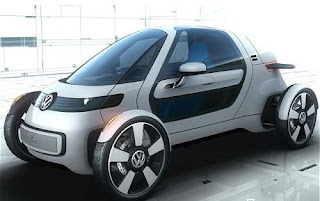
With a range of 40 miles and a top speed of 80mph, NILS would be ideal for the majority of commuters.
Looking closely related to its 170mpg L1 hybrid concept car from 2009, the new NILS concept from VW is a single-seat electric glimpse into a new form of minimalist mobility from the German carmaker.
Featuring an aluminum spaceframe, gullwing doors and exposed wheels, NILS has the dynamics of a sports car, yet travels silently with zero emissions. The project was supported by the German Federal Ministry of Transport, Building and Urban Development, and was designed to be both technically realistic and economically supportable.
With a range of 40 miles and a top speed of 80mph, NILS would be ideal for the majority of commuters, according to the German Bureau of Statistics, which reports 73.9 per cent of all commuters residing between Berlin and Munich cover less than 15.5 miles on their way to work without a passenger.
In Germany, about 60 per cent of all commuters travel by car, and of these more than 90 per cent travel alone. Therefore, Zero-emissions vehicles like NILS could offer these drivers an eco-friendly solution.
NILS is very compact and requires little space in traffic. It is only 120” long – making it about 20” shorter than the new VW up! – just 15” wide from wheel to wheel, and a mere 47” tall.
NILS has the same basic layout as a F1 racecar, with the driver in the middle, the engine in back, and outboard wheels at each corner. The 17” wheels are equipped with 115/80 (front) and 125/80 (rear) tires designed with low rolling resistance.
Because NILS is so compact and lightweight (1014 lb), it is fun to drive. It has a top speed of 80mph, and can accelerate to 62mph in less than 11 seconds. This is achieved using an electric motor with a reasonably small 15kW nominal power and short-term peak power of 25kW. A lithium-ion battery supplies the electric motor with energy.
The battery capacity (5.3kWh) enables driving ranges of up to 40 miles, depending on the style of driving.
A battery of this size is relatively inexpensive, and can be charged either via a conventional 230-volt European electrical outlet (maximum charging time two hours) or at an electric vehicle charging station. The socket is located at the back underneath the rear lighting module.
The centrepiece of the electric drive system is the lightweight 42 lb electric motor together with its transmission and battery. Energy management is via a high-voltage pulse inverter, which – together with the 12-Volt DC/DC converter for the vehicle electrical system and the charger – forms an integral drive unit.
All drive unit components are located in an aluminum housing at the rear of NILS and so drive is to the rear wheels.
The motor, battery and all other components are so compact that there is still space for a small but practical trunk space. The body-coloured area above the rear lighting module swings upward, revealing space for bags.
Optimal weight distribution helps ensure NILS allows drivers not only to commute with zero emissions, but also to have fun while doing so. The steering is purely mechanical (the low weight means power assistance is unnecessary), while the electric motor produces its maximum torque of 96 lb/ft from standstill, via a one-speed transmission.
Suspension is by double wishbones front and rear; while ESP helps to tame any over-exuberance on the part of the driver.
The instrument cluster is a seven-inch TFT display. The vehicle’s speed is shown digitally in the middle, while energy flow is represented by bars. Another graphic display offers information on the driving range.
The second central instrument is a mobile multifunctional device like the one used in the new up!: the Portable Infotainment Device (PID). It is snapped into the A-pillar to the right of the instrument cluster. Via touchscreen, the driver controls functions related to navigation, radio, media, telephone, trip computer and – to pre-configure the driving range – Eco.
The PID computes the expected driving range, then it not only displays the route on the map display, but also the radius and thereby the destinations that can be reached using the current battery charge.
The aluminium space frame body was designed to be a safety cell. The body in white is produced from extruded aluminum, cast aluminum and sheet aluminum. The roof frame, together with the door mounts, a roll-bar, the trunk and front bulkhead are made from high-strength sheet aluminum. Extruded aluminum is used in the side sills, the transverse profiles and the front and rear sections. The side body panels are aluminum.
Parts made from high-strength plastic include the bumpers and trim panels on the side sills.
SOURCE: eurotuner






